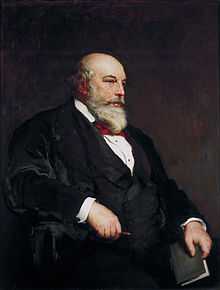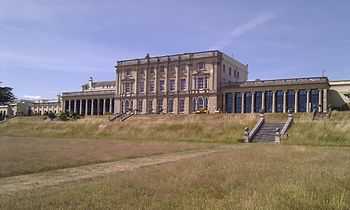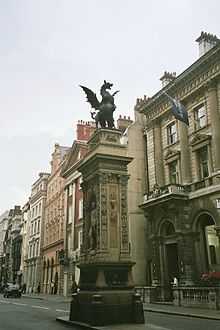Horace Jones (architect)

Sir Horace Jones (20 May 1819 – 21 May 1887) was an English architect particularly noted for his work as Architect and Surveyor to the City of London from 1864 until his death. His most recognised work is Tower Bridge, a world famous London landmark. Jones served as president of the Royal Institute of British Architects from 1882 until 1884, and was knighted on 30 July 1886.
Biography



The son of David Jones, attorney, by Sarah Lydia Shephard, Jones was born at 15 Size Lane, Bucklersbury, London. He was articled to John Wallen, architect and surveyor, of 16 Aldermanbury, and subsequently in 1841-42 travelled to Italy and Greece studying ancient architecture.
In 1843 he commenced practice as an architect at 16 Furnival's Inn, Holborn. Beginning with Cardiff Town Hall (c. 1850-53) and Caversham Park (from c. 1850), he designed and carried out many buildings of importance, soon concentrating on London. He was surveyor for the Duke of Buckingham's Tufnell Park estate, for the Barnard estate, and the Bethnal Green estate.
On 26 February 1864 he was elected architect and surveyor to the City of London, succeeding James Bunstone Bunning. Jones completed projects begun by his predecessor, such as the City Lunatic Asylum at Dartford, and was in charge of several renovations and additions to the Guildhall. He designed and built some of London's most famous markets, in particular Smithfield, Billingsgate and Leadenhall. He also designed the memorial at Temple Bar, replacing Wren's arch which was a notorious traffic obstacle.
Jones' final legacy is one of the most recognised buildings in the world but one he would never see himself, the Tower Bridge. He had teamed up with civil engineer John Wolfe Barry, son of famous architect Sir Charles Barry, who was brought in as an expert to devise the mechanism for the bascule bridge. With Jones' dying during the initial stages of construction, the execution lay in the hands of Barry.
An associate of the Royal Institute of British Architects in 1842, he became a fellow in 1855 and its president from 1882 to 1883. On 30 July 1886 he was knighted. He was also a freemason, and from 1882 until his death was Grand Superintendent of Works.
Jones married, 15 April 1875, Ann Elizabeth, daughter of John Patch, barrister. He died at 30 Devonshire Place, Portland Place, London, and was buried in West Norwood Cemetery on 27 May. A portrait by Walter William Ouless RA was exhibited in the Royal Academy Exhibition in 1887.
Works
(all in London unless stated otherwise)
Destroyed
- Cardiff Town Hall, c. 1850-53, demolished 1913. Image at Gathering the Jewels.
- Marshall & Snelgrove's department store, Oxford Street, 1850s. Image at Media Storehouse.
- Surrey Music Hall, 1856.
- Sovereign Assurance offices, Piccadilly, 1857.
- British and Irish Magnetic Telegraph Company's office, Threadneedle Street, 1859. Image at Distant Writing.
- Council Chamber, Guildhall, 1884.
Extant
- Caversham Park, Oxfordshire, c. 1850 (now within the borough of Reading, Berkshire).
- Smithfield Market. Built in three stages: Central Meat Market, 1866–67; Poultry and Provision Market, 1873–5 (burnt 1958); Fruit and Vegetable Market, 1879–83.
- Foreign Cattle Market, 1871. Conversion of Convoys Wharf, Deptford.
- Library and Museum, Guildhall, 1872 (now fulfilling different functions).
- Billingsgate Market, 1874-78 (1985-89 converted into offices by Richard Rogers).
- Temple Bar Memorial, 1880. The elaborate pedestal in a Neo-Renaissance style, decorated with some reliefs as well as statues of Queen Victoria and The Prince of Wales, serves as the base for Charles Bell Birch's Griffin (but really a dragon), the symbol of the City of London.[1]
- Leadenhall Market, 1880-81.
- former Guildhall School of Music and Drama, John Carpenter Street, completed in 1886.
- Tower Bridge, approved design 1884, construction by John Wolfe Barry 1886-94. Jones' stonework in the Baronial Style, supposed to be in harmony with the nearby Tower of London, is pure facade which disguises the thoroughly modern metal structure underneath.[2]
References
 This article incorporates text from a publication now in the public domain: "Jones, Horace". Dictionary of National Biography. London: Smith, Elder & Co. 1885–1900.
This article incorporates text from a publication now in the public domain: "Jones, Horace". Dictionary of National Biography. London: Smith, Elder & Co. 1885–1900.
External links
- G. C. Boase, Jones, Sir Horace (1819–1887) rev. Valerie Scott, Oxford Dictionary of National Biography, 2004 (Subscription required)
- Sir Horace Jones, biography at the Tower Bridge Restoration website
|